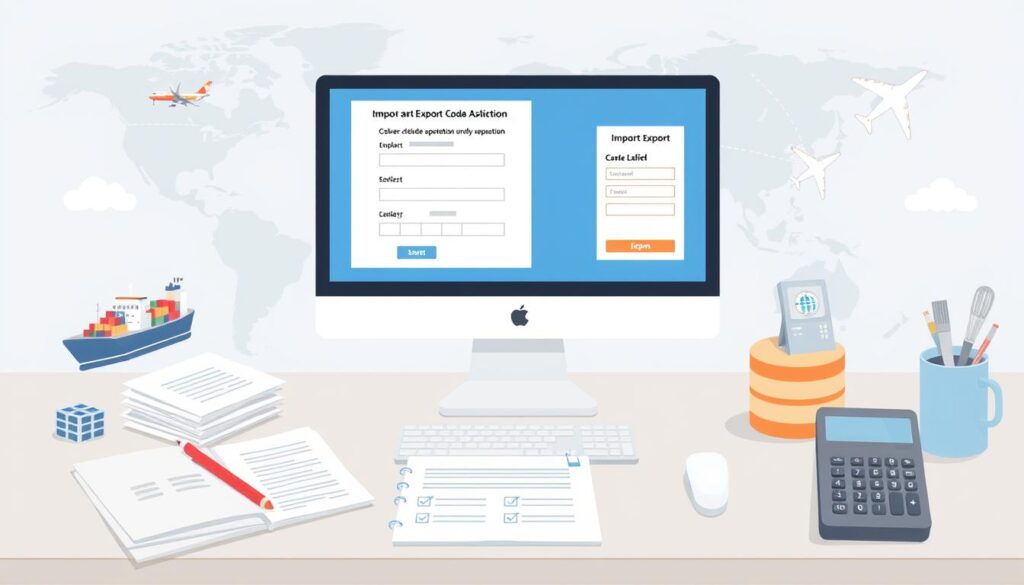Ever wondered how the Indian government buys things? It’s all through the Government e-Marketplace (GeM) portal. This e-procurement system is a big change for buying and selling online.
GeM is a place where government groups, PSUs, and others can buy goods and services. It makes buying faster, cheaper, and more transparent. With over 25 lakh sellers, it’s the top choice for government buying in India.
GeM has lots of products and services. You can find about 52 lakh products in 16,409 categories and 193 service categories. It has everything from office supplies to special equipment. Sellers can join for free, with a small deposit based on their sales.
Using GeM is easy. Buyers can buy up to Rs.50,000 online directly. For bigger buys, there’s a bidding process. Sellers can change their prices anytime, making sure the government gets a good deal.
Key Takeaways
- GeM is a free-to-register online marketplace for government procurement
- Over 25 lakh sellers and 52 lakh products are available on the platform
- Buyers can make direct purchases up to Rs.50,000 per week
- The portal offers 193 service categories, including manpower and vehicle hiring
- GeM uses natural language processing for efficient product searches
- Multilingual customer support is available for users
- Small sellers have increased access to public procurement through GeM
Introduction to GeM Portal
The Government e-Marketplace (GeM) portal changes how Indian government groups buy things. It makes buying easier with a big selection of products and services. You can find dynamic pricing, direct buying, and tools for auctions on GeM.
GeM has made a big difference in how the government buys things. By February 2023, it had handled orders worth INR 3.50 lakh Crores. It has over 66,000 buyers and 58 lakh sellers. The site has more than 30 lakh products in 11,358 categories and 278 services.
Using GeM can save money. A World Bank study found buyers save an average of 9.75% on prices. The site is known for being efficient and transparent. It won the CIPS award for ‘Best use of digital technology’ in 2021.
| GeM Portal Statistics | Value |
|---|---|
| Total Order Value (as of Feb 2023) | INR 3.50 lakh Crores |
| Buyer Organizations | 66,663 |
| Sellers & Service Providers | 58,93,283 |
| Product Categories | 11,358 |
| Service Categories | 278 |
GeM has many benefits, but it also has some downsides. New users might find it hard to learn, and it can have technical problems when lots of people use it. Still, GeM has made government buying more open and efficient.
Benefits of Using GeM Portal
The Government e-Marketplace (GeM) portal offers many benefits for both buyers and sellers. It has changed how the government buys things in India, making it faster and clearer.
Streamlined Procurement Process
GeM makes buying easier by cutting down on paperwork and time. It has over 48 lakh products in 10,000 categories. This means buyers can quickly find what they need.
The portal also lets buyers order online and create contracts without needing someone else. This makes the whole process much faster.
Transparency and Accountability
The GeM portal makes things clear by using online transactions and keeping records. Sellers must meet ‘Country of Origin’ rules, making sure products are from India. Buyers can keep an eye on everything through a simple dashboard.
Cost Savings for Government Organizations
GeM helps save money by offering good prices and bulk deals. For small purchases up to Rs.25,000, no comparison is needed. But for bigger orders, it uses a reverse auction to find the best price.
| Purchase Amount | Procurement Method |
|---|---|
| Up to Rs.25,000 | Direct purchase without comparison |
| Rs.25,001 – Rs.5,00,000 | L1 purchase after comparing at least three different suppliers |
| Above Rs.5,00,000 | Reverse auction tool for lowest price selection |
The GeM portal is a big help for government buying. It’s easy to sign up as a vendor, and there are over 38 lakh sellers. It’s changing how government bodies buy goods and services.
Registering on GeM Portal
Learning to use GeM portal begins with user registration. The Government e-Marketplace (GeM) makes it easy for sellers and buyers to connect. Let’s look at what you need and how to register.
Requirements for Registration
To sign up on GeM, you’ll need a few important documents:
- PAN card
- Udyog Adhaar (MSME certificate)
- GST registration certificate
- Cancelled cheque copy
- Aadhaar Card
Sellers also have to pay a Caution Money Deposit. The amount depends on their turnover:
| Seller Turnover | Deposit Amount |
|---|---|
| Less than 1 Crore | Rs 5,000 |
| Between 1 Crore and 10 Crores | Rs 10,000 |
| More than 10 Crores | Rs 25,000 |
Primary User Registration Process
Here’s how to register as a primary user on GeM:
- Go to the GeM portal
- Click ‘Register as a Seller’
- Use your PAN or Aadhaar number
- Enter your company details and location
- Submit your GST information
- Add your bank account details
- Pay the caution money deposit
Secondary User Roles and Responsibilities
Primary sellers can add secondary users with different roles:
- Buyer: Manages purchases and bids
- Consignee: Handles delivery and quality checks
- DDO (Drawing and Disbursing Officer): Oversees financial transactions
- Paying Authority: Processes payments
Each role has its own tasks in the procurement process. This ensures everything runs smoothly on GeM.
By knowing these registration needs and steps, you’re ready to start on GeM, whether buying or selling.
Navigating the GeM Portal Interface
The GeM portal has a user-friendly interface to make government procurement easier. When you log in, you see a dashboard with quick access to important functions. It’s divided into sections for product catalogs, purchase orders, and user management.
The GeM portal’s search function is powerful. You can find products or services by keywords, categories, or attributes. The filtering options let you narrow down results by price, quality, or seller ratings.
The interface also has tools for comparing products and services. This helps you make better choices by looking at specifications, prices, and seller performance.
Managing Your Account
Your GeM portal account offers:
- Personal dashboard for quick overview
- Profile management tools
- Transaction history
- Bidding tools for participating in tenders
- Payment systems for secure transactions
The GeM portal’s interface is updated regularly to improve user experience. By getting to know these features, you can get the most out of the GeM platform for your needs.
| GeM Portal Statistics | As of September 2, 2024 |
|---|---|
| Primary Buyers | 377,366 |
| Gross Merchandize Value (INR crore) | 216,109 |
| Total Orders in Current Fiscal Year | 2,154,471 |
| Product Categories | 11,292 |
| Service Categories | 328 |
| Seller & Service Providers | 9,222,833 |
Making Direct Purchases on GeM
The Government e-Marketplace (GeM) makes buying easier for government groups. It’s a fast way to get what you need, but there are rules to follow.
Purchase Limits and Procedures
GeM has rules for buying things based on how much you want to spend:
- Up to Rs. 50,000: Buy from any available supplier
- Rs. 50,000 to Rs. 30,00,000: Choose the lowest price from at least three sellers
- Above Rs. 30,00,000: Use online bidding or reverse auction
These rules help ensure fair prices and good value for government money. Only certain officers can make these purchases.
Certifying Reasonability of Rates
Buyers must check if prices are fair. GeM has tools to help compare prices. Remember, prices on GeM change and only apply to online buys.
| Purchase Amount | Procedure |
|---|---|
| Up to Rs. 50,000 | Any available supplier |
| Rs. 50,000 – Rs. 30,00,000 | Lowest price among 3 manufacturers |
| Above Rs. 30,00,000 | Online bidding or reverse auction |
To use GeM well, you need an Aadhaar-linked phone for verification. Only government emails can sign up. By following these steps, you can buy efficiently and legally on GeM.
Participating in Bids and Reverse Auctions
The Government e-Marketplace (GeM) portal has great tools for online bidding and reverse auctions. These tools make buying things for the government easier and more open. They help make sure everything is done right and fast.
Creating and Managing Bids
On GeM, you can easily make and handle bids. When you start a bid, you can list out what you need and how to judge it. This makes sure everyone knows what you want.
For big purchases over Rs. 30,00,000, you must use these online tools. But, you can also use them for smaller buys if you want. The site is easy to use, helping you through every step of bidding.
Reverse Auction Process
Reverse auctions on GeM are a smart way to get the best prices. Suppliers compete live, offering lower prices for what you need. This can save a lot of money for government groups.
To join a reverse auction:
- Set up your auction details
- Invite the right suppliers
- Watch the auction live
- Choose the best offer
The GeM portal has clear rules for fair and clear deals. Using these strong bidding and auction tools helps you get more value and do things better.
“GeM’s reverse auction feature has changed how we buy things, saving a lot of money and making suppliers compete more.”
Payment and Delivery Processes
The Government e-Marketplace (GeM) makes buying easier for government groups. It has a clear payment and delivery system. Let’s see how these parts work on the GeM portal.
Consignee Payment and Approval
The payment process on GeM is well-organized. When goods arrive, the buyer makes a Provisional Receipt Certificate (PRC). After checking, they give a Consignee Receipt and Acceptance Certificate (CRAC).
For PFMS users, the DDO sends bills to the PAO for payment. Non-PFMS users can make payments directly.
Delivery Timelines and Penalties
The delivery on GeM is fast. Contracts set delivery times to keep things moving. If sellers are late, they face penalties.
This system pushes for on-time deliveries. It keeps the buying process smooth and efficient.
| Aspect | Details |
|---|---|
| Payment Process | PRC > CRAC > Bill Forwarding > Payment |
| Delivery Timeline | Specified in contract |
| Late Delivery Penalty | Standard LD clause applies |
GeM’s payment system makes online deals easy and fast. It cuts down on time and boosts trust. This helps both buyers and sellers, making government buying better and cheaper.
What is GeM portal and how to use it?
The Government e-Marketplace (GeM) portal is India’s national public procurement platform. It’s an online marketplace for government organizations to buy goods and services efficiently. This guide will help you understand its features and usage.
Overview of GeM Portal Features
GeM offers many features to make procurement easier:
- Product catalogs with over 30,81,000 items across 11,358 categories
- 278 service categories available
- Dynamic pricing and bidding tools
- Integrated payment system
- Transparent seller ratings and reviews
Step-by-Step Guide to Using GeM Portal
Here’s how to use the GeM portal and make purchases:
- Register as a primary or secondary user
- Log in to your account
- Browse or search for products/services
- Add items to cart or initiate bidding
- Complete the purchase process
- Manage delivery and payment through the portal
The GeM portal has helped with orders worth INR 3.50 lakh Crores as of February 2023. It has 66,663 buyer organizations and over 58 lakh sellers. It’s a strong platform for government procurement.
| Feature | Benefit |
|---|---|
| End-to-end online marketplace | Streamlined procurement process |
| Wide range of products and services | One-stop solution for diverse needs |
| Dynamic pricing | Cost savings (average 9.75% on median price) |
| Transparent transactions | Increased accountability |
By following this guide, you can use the GeM portal to meet your procurement needs. It ensures transparency and cost-efficiency.
Conclusion
The Government e-Marketplace (GeM) portal has changed how India buys things online. It has over 5.9 lakh sellers and offers 33 lakh products. This shows how big its impact is on government buying.
GeM is available in 1.5 lakh+ India Post offices and 5.2 lakh+ Village Level Entrepreneurs. It’s ranked third globally for buying things online. It’s known for being open, efficient, and saving money.
For sellers, GeM opens up a big market and chances to grow, especially for small businesses. Buyers get a wide range of products, good prices, and quality checks. GeM is on its way to becoming the top place for public buying in India, helping the country grow economically.
FAQ
Q: What is the GeM portal?
A: GeM (Government e-Marketplace) is an online platform for government buying in India. It makes buying goods and services easier and cheaper for government groups and others.
Q: What are the benefits of using the GeM portal?
A: Using GeM has many advantages. It simplifies buying, making it faster and less paperwork. It also saves money by offering competitive prices and bulk deals. Plus, it’s easy to register vendors and has a wide range of suppliers.
Q: How do I register on the GeM portal?
A: To register on GeM, you need an Aadhaar-linked mobile and a government email. First, the Head of Department (HoD) signs up, then others. You’ll need to verify your Aadhaar, provide your email, and share your job title. You can then add others with roles like Buyer or DDO.
Q: How does the GeM portal interface work?
A: The GeM portal is easy to use. It has sections for products, orders, and managing users. You can search, filter, and compare items. It also lets you check your dashboard, manage your profile, and see your transaction history.
Q: What are the purchase limits and procedures for direct purchases on GeM?
A: Direct purchases on GeM have limits. You can buy up to Rs. 50,000 from any supplier. For Rs. 50,000 to Rs. 30,00,000, you need at least three sellers. Anything over Rs. 30,00,000 needs online bidding. Always check if the prices are fair.
Q: How do bidding and reverse auctions work on GeM?
A: GeM has tools for online bidding and auctions. Buyers can set up and manage bids with specific needs. In auctions, suppliers compete to offer lower prices. These are required for big purchases and optional for smaller ones.
Q: What is the payment and delivery process on GeM?
A: Payment on GeM starts with a Provisional Receipt Certificate (PRC) and a Consignee Receipt and Acceptance Certificate (CRAC). For PFMS users, the DDO sends bills for payment. Non-PFMS users have a Paying Authority role for direct payments. Delivery times are set in contracts, with penalties for late delivery.









